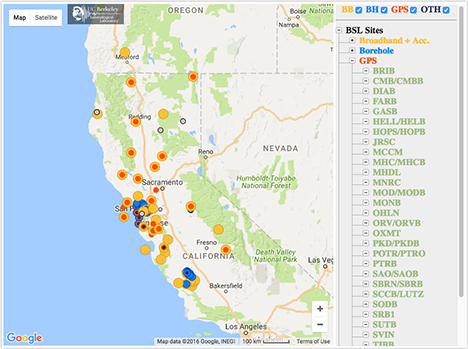Bay Area Regional Deformation Network


BARD is a network of 33 continuously operating Global Positioning System receivers in Northern California. The primary goal of the network is to monitor crustal deformation across the Pacific-North America plate boundary and in the San Francisco Bay Area for earthquake hazard reduction studies and rapid earthquake emergency response assessment. Join the BARD-info mailing list for network announcements, including information on station upgrades, outages and other problems and new data products, such as real-time streaming.
- BARD Station List
-
- Data Access
-
Receiver data, both raw and RINEX 24-hour files, are archived and available at the NCEDC. The raw and RINEX data files are in day-of-year directories in either our normal (lowrate) or highrate directories. Site logs are also available at the NCEDC. More station information, including timeseries and data quality evaluation information, is available for BARD backbone sites.
Many of the BARD stations have been upgraded to highrate (1 sample/second) sampling. For highrate sampling, we archive the raw data at highrate, and archive decimated lowrate (1 sample every 15 seconds) RINEX files. For stations that still sample every 15 or 30 seconds, we archive both the raw and RINEX data at that sample rate. We only archive highrate RINEX data for selected stations where we receive only the RINEX data files.
- Lowrate Data (15 or 30 second sampling)
- Highrate Data (1 sample per second sampling)
- Holdings listed by GPS Week
When you use data from the NCEDC or BARD network, please provide a proper acknowledgement of the data source.
- Analysis
-
The data are analyzed at the U.S. Geological Survey to find the relative displacements of the stations:
Data from the BARD network may also be used for surveying applications. For legal purposes, the BSL relies on adjustments performed by the California Spatial Reference Center (CSRC), in partnership with the National Geodetic Survey, to provide precise NAD83 reference frame coordinates suitable for use by the surveying community. Many of the BARD stations are included in a 2000 adjustment following the Hector Mine earthquake, which were officially sanctioned by NGS in March 2001. These coordinates can also be obtained from NGS.
- Reports
-
- Report on the Mini-PBO Borehole Adapter for GPS
- Publications
- BARD Project Reports
- 2019 USGS Annual Project Summary
- 2010-2015 Final Technical Report
- BARD section of 2013/2014 BSL Annual Report (see Operations Section, Chapter 6)
- BARD section of 2012/2013 BSL Annual Report (see Operations Section, Chapter 5)
- BARD section of 2011/2012 BSL Annual Report (see Operations Section, Chapter 5)
- BARD section of 2010/2011 BSL Annual Report (see Operations Section, Chapter 5)
- 2007 USGS Annual Project Summary (pdf)
- 2004-2006 Final Report (pdf)
- 2001-2004 Final Report (pdf)
- 2000 USGS Annual Project Summary (pdf)
- Acknowledgment of Support:
- This material is based upon work supported by the U.S. Geological Survey under Grants No. G15AC00081 and No. G10AC00141.
- Disclaimer:
- The views and conclusions contained in this document are those of the authors and should not be interpreted as representing the opinions or policies of the U.S. Geological Survey. Mention of trade names or commercial products does not constitute their endorsement by the U.S. Geological Survey.
- Collaborations
-
The BARD network is a collaborative effort of the:
- Other useful links
-
- Crustal Deformation
- Northern California - USGS Menlo Park
- Southern California - USGS Pasadena
- USGS Real-time Monitoring
- GPS
- GPS - General GPS information
- CDDIS - NASA Crustal Dynamics Data Information System
- IGS - International GPS Service for Geodynamics
- SOPAC - Scripps Orbit and Permanent Array Center
- SCIGN - Southern California Integrated GPS Network
- NGS - National Geodetic Survey
- BARGEN - Basin and Range Geodetic Network
- GAGE - The Geodetic Facility for the Advancement of Geoscience
- PANGA/CWU - Pacific Northwest Geodetic Array, Central Washington University
- PANGA/UW - Pacific Northwest Geodetic Array, University of Washington
- WDCA/PGC - Western Canada Deformation Array, Pacific Geoscience Center
- NCGPSUG - Northern California GPS Users Group
- CGCC - California Geodetic Control Committee
- CSRC - California Spatial Reference Center
- Crustal Deformation
Please send comments and questions to bard@seismo.berkeley.edu.
